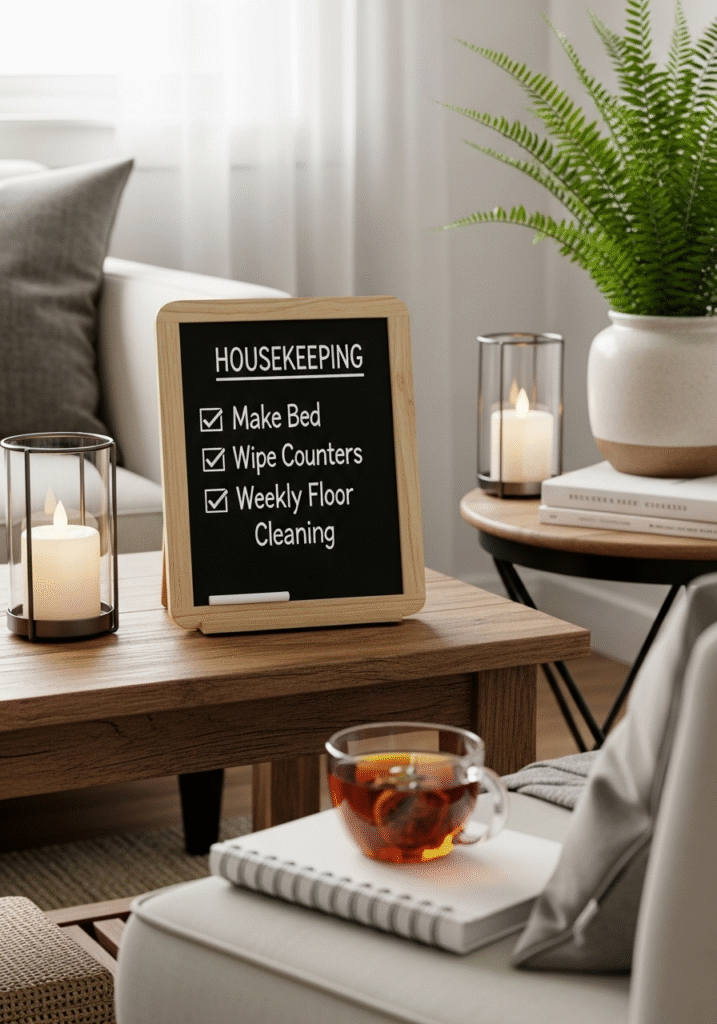In today’s fast-paced world, finding the time to keep your home clean and well-maintained can feel overwhelming. Whether you’re juggling work, family, or a busy social calendar, maintaining a tidy and functional living space doesn’t have to consume your weekends. This comprehensive guide is packed with smart, efficient cleaning hacks and easy-to-follow home maintenance tips specifically designed for people with limited time but high standards for comfort and cleanliness.
Learn how to streamline your cleaning routine with clever time-saving tricks, like using natural multi-purpose cleaners, breaking chores into manageable daily tasks, and adopting the “clean as you go” method to prevent messes from piling up. Discover expert strategies for keeping your home in tip-top shape with minimal effort, including seasonal checklists, quick appliance upkeep, preventative maintenance tips, and simple organizational solutions to reduce clutter for good.
Whether you live in a small apartment or a bustling family home, these proven techniques will help you maintain a fresh, inviting space without sacrificing your schedule. With the right approach, you can enjoy a clean, healthy environment—and reclaim your free time.
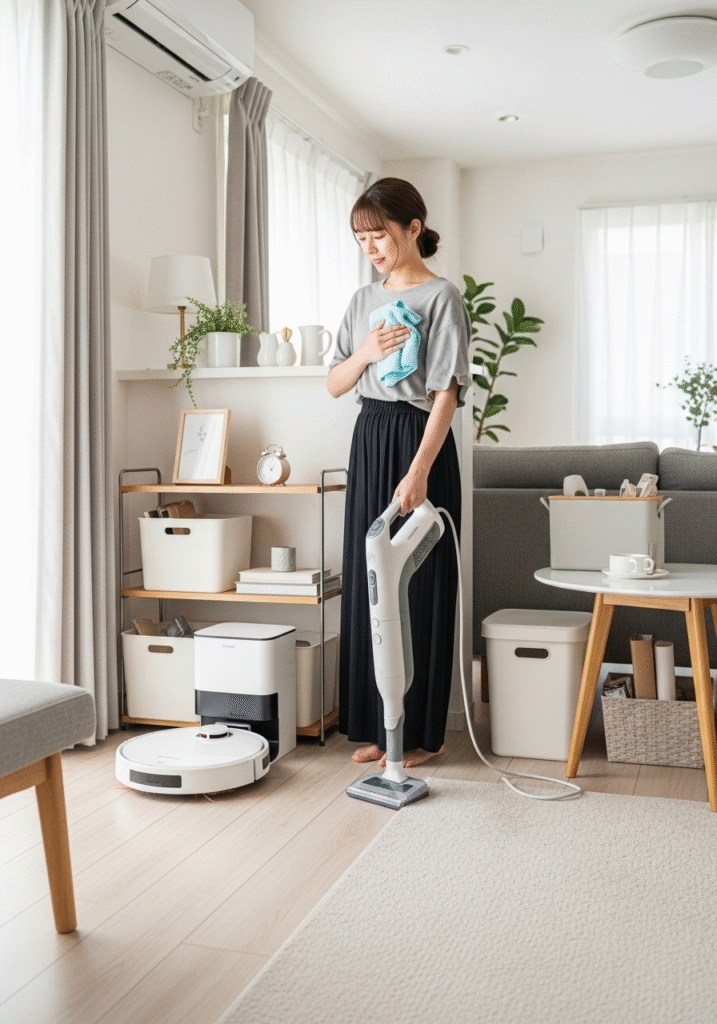
Introduction
Keeping a home clean and well-maintained can often feel like an impossible task when you’re constantly on the go. Between work deadlines, family responsibilities, social engagements, and carving out a bit of time for yourself, deep cleaning usually falls to the bottom of the list—or worse, off the list entirely. But the truth is, maintaining a clean, organized, and welcoming home doesn’t have to be a time-consuming ordeal. With the right strategies, even the busiest individuals can keep their living spaces fresh and functional without dedicating entire days to cleaning.
This guide is designed specifically for people with hectic schedules who still want to enjoy the peace and comfort of a well-kept home. Inside, you’ll find realistic, actionable cleaning hacks that fit into your daily routine—no matter how packed it may be. These time-saving tips focus on efficiency, consistency, and smart organization, allowing you to tackle messes before they build up and create an environment that’s easier to manage.
From 10-minute nightly resets and multi-tasking cleaning techniques to clever storage solutions and preventative maintenance checklists, every strategy here is tailored to help you make the most of your limited time. You’ll learn how to:
- Break cleaning tasks into manageable micro-routines
- Use everyday products and tools for quicker, more effective results
- Establish a realistic cleaning schedule that actually sticks
- Incorporate simple maintenance habits to prevent larger issues later
- Organize your home in a way that reduces clutter and saves time
Whether you live alone, with roommates, or have a full household to care for, this guide empowers you to reclaim your time without sacrificing the cleanliness or comfort of your home. Say goodbye to weekend-long cleaning marathons and hello to a stress-free, sparkling space—all achieved through smart, sustainable habits.
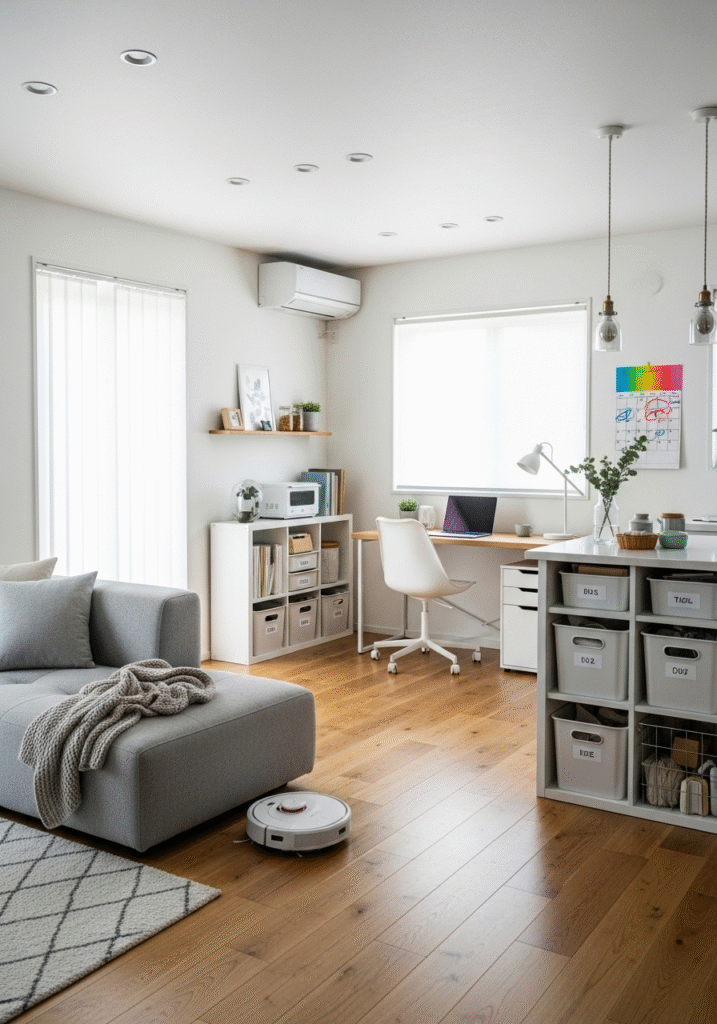
Why Busy Lifestyles Don’t Have to Mean a Messy Home
A busy life doesn’t have to translate into a chaotic or messy home. While it’s easy to feel overwhelmed by housework when your schedule is packed, the truth is that maintaining a clean and comfortable space is less about deep-cleaning marathons and more about consistency. Clutter and dirt don’t appear overnight—they build gradually over time. Fortunately, the same principle applies in reverse: small, intentional efforts made regularly can prevent messes from getting out of control.
Instead of waiting for your one free day to tackle everything at once, shifting your mindset toward quick, daily upkeep can make a huge difference. By dedicating just 5 to 15 minutes a day to targeted tasks—such as wiping down counters, doing a quick floor sweep, or returning items to their place—you stop clutter from accumulating and keep your home looking guest-ready at all times.
This micro-cleaning approach not only saves time in the long run but also reduces mental clutter. A tidy, well-kept environment can have a noticeable impact on your mood and productivity. You’ll feel more relaxed, more focused, and less stressed when your surroundings are clean and under control—even if you didn’t spend hours making them that way.
Here’s what just a few minutes of daily effort can do for you:
- Prevent mess from piling up: Tackle little tasks before they turn into big problems, like dishes stacking up or laundry taking over the couch.
- Keep surfaces clean and usable: Clean countertops, tables, and entryways make your space feel instantly more organized and welcoming.
- Save time and stress on weekends: With daily maintenance, you won’t have to devote your entire Saturday to catching up on chores.
- Promote a healthier, more peaceful environment: Less dust, fewer allergens, and a clutter-free space help support both physical and mental well-being.
By embracing the idea that a few minutes a day is all it takes, you’ll begin to see your home not as another chore on your list, but as a place of rest and retreat—even in the middle of your busiest weeks.
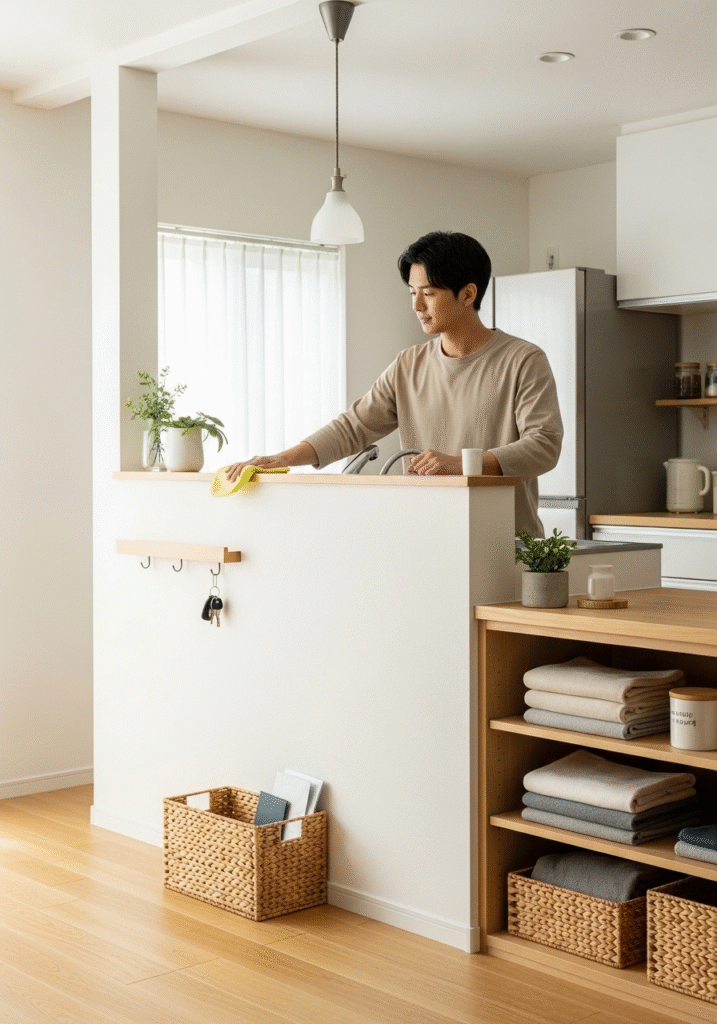
Daily Micro‑Habits (< 10 Minutes)
When time is limited, the key to keeping your home clean isn’t found in big weekend clean-ups—it’s in small, repeatable habits that take less than 10 minutes a day. These micro-habits may seem minor on their own, but together they create a powerful ripple effect, keeping your living space consistently tidy, functional, and welcoming with minimal effort. The beauty of these daily routines is that they’re easy to build into your existing schedule—and once they become second nature, your home practically maintains itself.
Here are a few simple, yet highly effective micro-habits you can start today:
3.1 Two-Minute Counter Clean
What it is: A quick wipe-down of your kitchen and dining surfaces using a ready-to-go cleaning kit.
How to do it: Keep a multi-surface spray and a clean microfiber cloth in an easily accessible spot in your kitchen. After preparing a meal or even making coffee, set a 2-minute timer and wipe down all visible surfaces: countertops, stove tops, dining tables, and sink rims. These are the areas that collect spills, crumbs, grease, and smudges most often.
Why it works: This quick ritual eliminates buildup before it becomes stubborn grime. It also helps maintain a hygienic kitchen and reduces the amount of deep-cleaning needed later. Plus, returning to a clean surface every time you cook or eat adds a sense of calm and order to your day.
3.2 Bed-Making Power Minute
What it is: Making your bed as soon as you get up—before you even leave the room.
How to do it: As soon as you rise, straighten your sheets, fluff the pillows, and smooth your comforter. Don’t worry about perfection; the goal is neatness, not luxury-hotel standards. You’ll be surprised what a minute or two can accomplish.
Why it works: Making your bed sets a visual tone of order and calm for your entire bedroom. It also gives you a small win first thing in the morning, which can increase motivation and productivity throughout the rest of your day. Over time, this small act can help shift your mindset toward tidiness in other parts of your home.
3.3 Shoe-Free Zone
What it is: A simple habit of removing your shoes as soon as you enter the house.
How to do it: Place a shoe rack or basket near your front door and keep a comfortable pair of indoor slippers or clean socks nearby. As you come in, slip off your shoes and switch to your indoor footwear. Encourage your household and guests to do the same.
Why it works: Shoes carry dirt, allergens, and bacteria from outside into your home. By removing them at the door, you drastically reduce how much grime ends up on your floors and carpets, especially in high-traffic areas. It’s one of the easiest ways to keep your floors cleaner for longer—saving you from frequent vacuuming and mopping.
Together, these three habits take less than 5–7 minutes total each day, yet they dramatically reduce visual clutter, protect your surfaces, and set the tone for a cleaner, more intentional home environment. They’re ideal for anyone who feels like there just isn’t enough time to clean—because with micro-habits, a little truly goes a long way.
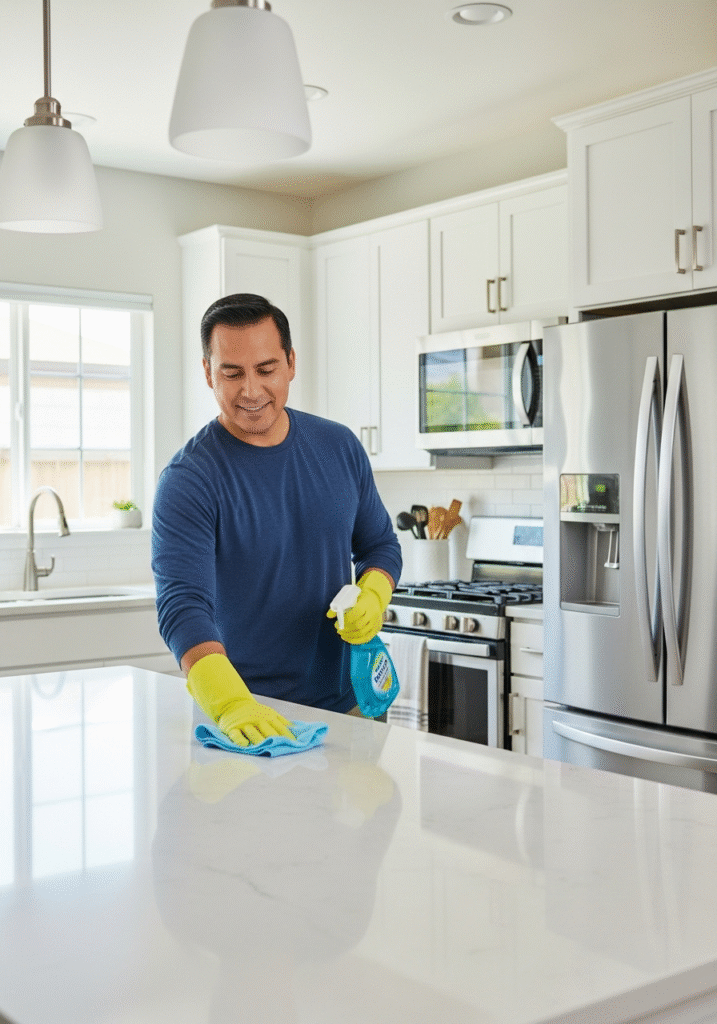
Weekly Quick‑Clean Routine (< 30 Minutes/Day)
A clean and organized home doesn’t require hours of daily work—just a smart, consistent routine. By breaking up chores into focused tasks spread across the weekdays, you’ll maintain a neat and pleasant home environment without feeling overwhelmed. This quick-clean plan takes under 30 minutes a day and covers the most essential areas of your home.
4.1 Monday: Kitchen Deep Spot
Start the week strong by giving your kitchen a quick but meaningful refresh. After a busy weekend, your kitchen likely needs a little TLC. Focus on the most-used and most visible areas:
- Load/Unload the Dishwasher or Hand-Wash Dishes: Clear out the sink and countertops by finishing any dishwashing. Unload clean dishes from the dishwasher or dish rack to make space. If you’ve been hand-washing, dry and put away any lingering utensils, plates, or pans.
- Wipe Down Appliance Surfaces: Grab a multipurpose cleaner or a gentle disinfectant and wipe down high-touch areas like the refrigerator handles, the outside of the microwave, oven knobs, and other small appliances like the coffee maker or toaster.
- Clean the Sink and Drain: Sinks can get grimy fast. Use a scrub brush or sponge with baking soda or a cleaner to scrub the sink basin and around the drain. For freshness, pour a mix of vinegar and hot water down the drain to deodorize and remove light buildup.
4.2 Tuesday: Bathroom Blitz
Bathrooms require regular upkeep to stay hygienic and fresh, but they don’t need to take forever. Tuesday’s bathroom blitz gets the job done quickly and effectively:
- Scrub the Toilet: Use a toilet bowl cleaner and brush to scrub inside the bowl, including under the rim. Wipe down the seat, lid, tank, and especially the floor around the base of the toilet where dust, hair, and splashes can accumulate.
- Wipe Mirror and Countertop: Use a streak-free glass cleaner or vinegar-water solution to clean the mirror. Then, wipe the countertop and sink with a disinfectant wipe or cloth to remove water spots, toothpaste splatter, and grime.
- Quick Tub/Shower Wipe: Do a fast wipe-down of the tub or shower walls, especially where soap scum or mildew may start to build. To keep things low-maintenance, use a daily shower spray after each use—it helps reduce the need for scrubbing later.
4.3 Wednesday: Living Areas Tidy-Up
Midweek is the perfect time to hit reset on your shared living spaces. This task focuses on the visible clutter and comfort factors that make your home feel messy:
- Fluff Cushions and Fold Throws: Give your sofa a quick refresh by fluffing and repositioning pillows and neatly folding any throw blankets. It instantly makes the room look tidier and more put-together.
- Declutter Common Areas: Do a surface sweep of your living room, entryway, and dining area. Pick up any toys, paperwork, mail, or dishes that have been left out and return them to their proper places. Keep a small basket or bin handy if you’re short on time and want to sort it later.
- Wipe Down Surfaces: Use a microfiber cloth and a gentle cleaner to wipe down coffee tables, side tables, and TV stands. Clean any fingerprints or dust from electronics like the television screen or remote controls.
4.4 Thursday: Dust & Surfaces
Thursday is about reaching those often-neglected surfaces that quietly gather dust. A quick pass once a week keeps allergies down and surfaces looking fresh:
- Dust Key Areas: Use a microfiber duster or cloth to remove dust from bookshelves, picture frames, window sills, and other flat surfaces. Don’t forget decorative items like vases or figurines.
- Clean High-Touch Points: Door handles, light switch plates, and cabinet knobs can harbor bacteria and grime. Wipe them down with a disinfectant to keep them clean and safe.
- Ceiling Fans & Fixtures: For ceiling fans, slip a pillowcase over each blade and pull it back to trap dust without letting it fall to the floor. You can also use this time to dust light fixtures or lampshades if needed.
4.5 Friday: Floors & Entry
Wrap up your week with clean floors and a welcoming entryway. This gives your home a refreshed feel just in time for the weekend:
- Vacuum or Sweep High-Traffic Areas: Focus on spaces that see the most foot traffic—hallways, living rooms, and bedrooms. Vacuum rugs and sweep or vacuum bare floors, paying attention to corners and edges where dust bunnies hide.
- Mop Kitchen & Bathroom Floors: Use a mop or steam cleaner with an appropriate solution for your floor type. Give extra attention to sticky spots near the sink, stove, or toilet.
- Tidy Entryway: Shake out the doormat, sweep the porch or front step, and wipe down the front door if needed. Clean smudges off glass panels and polish the handle. A clean entryway sets the tone for the rest of the house and welcomes you (and guests) home.

Monthly Maintenance Tasks (1 Hour Max)
These monthly cleaning tasks go a little deeper than your weekly routine, helping you maintain a cleaner, healthier, and more pleasant home environment over the long term. Though they take a bit more time, each task can be done in under an hour—perfect for a weekend cleaning session or split across a couple of evenings. They tackle the areas that often get neglected but make a big difference in how fresh your home feels.
5.1 Oven/Fridge Clean
The kitchen works hard, and both the fridge and oven benefit from a monthly deep-clean to stay sanitary and functional.
- Fridge Refresh: Start by removing all items from your refrigerator. Discard anything expired, spoiled, or forgotten in the back of shelves and drawers. Wipe down interior surfaces with a mixture of warm water and mild dish soap or vinegar. Don’t forget to clean crisper drawers, door shelves, and under removable trays. Return items in an organized way, grouping similar items together.
- Oven Deep-Clean: If your oven has a self-cleaning cycle, use it—just follow safety instructions, including ensuring good ventilation. After the cycle, allow the oven to cool, then wipe out ash or debris. For manual cleaning, apply a store-bought oven cleaner or a baking soda paste to the interior, let it sit, then scrub and wipe clean. Don’t forget to clean the inside of the oven door and any removable racks.
5.2 Window & Mirror Wipe
Over time, glass surfaces can accumulate streaks, fingerprints, dust, and grime, especially in high-humidity areas like bathrooms and kitchens.
- Clear Glass Surfaces: Use a streak-free glass cleaner or a vinegar-water solution with a microfiber cloth to clean all accessible windows and mirrors throughout your home. Pay close attention to smudges near doorways, kids’ eye-level fingerprints, or areas exposed to steam and cooking. Open windows slightly to get to the edges and sills, and consider using a squeegee for larger glass panels to avoid streaking.
5.3 Upholstery & Carpet Spot Check
Soft surfaces quietly collect dust, allergens, and the occasional stain. A monthly inspection helps prolong their life and maintain cleanliness.
- Spot-Treat Stains: Check upholstered furniture, rugs, and carpets for spots or spills. Use a suitable upholstery or carpet cleaner to treat them—blot rather than scrub to avoid spreading the stain or damaging fibers. A simple mix of dish soap and water can work wonders for fresh stains.
- Vacuum Under Cushions: Lift couch cushions and vacuum beneath them to remove crumbs, dust, and debris. This is also a good opportunity to find lost items (like the remote or loose change) and fluff up the cushions before putting them back in place.
5.4 Vent Covers & Baseboards
Often overlooked, vents and baseboards collect dust, pet hair, and grime. Cleaning them monthly improves air quality and gives your home a sharper, well-maintained look.
- Vent Covers: Remove vent grilles (if easily detachable) and either vacuum them or wipe them with a damp cloth. If they’re especially dirty, wash them in warm, soapy water, then dry thoroughly before reinstalling. Don’t forget ceiling or floor vents, depending on your HVAC layout.
- Baseboard Care: Use a microfiber cloth or vacuum brush attachment to remove dust from baseboards along walls, behind doors, and under furniture. Follow with a damp cloth or mild cleaner to remove any scuffs or grime. Clean baseboards give a polished, finished look to any room—even if you don’t notice them day-to-day.
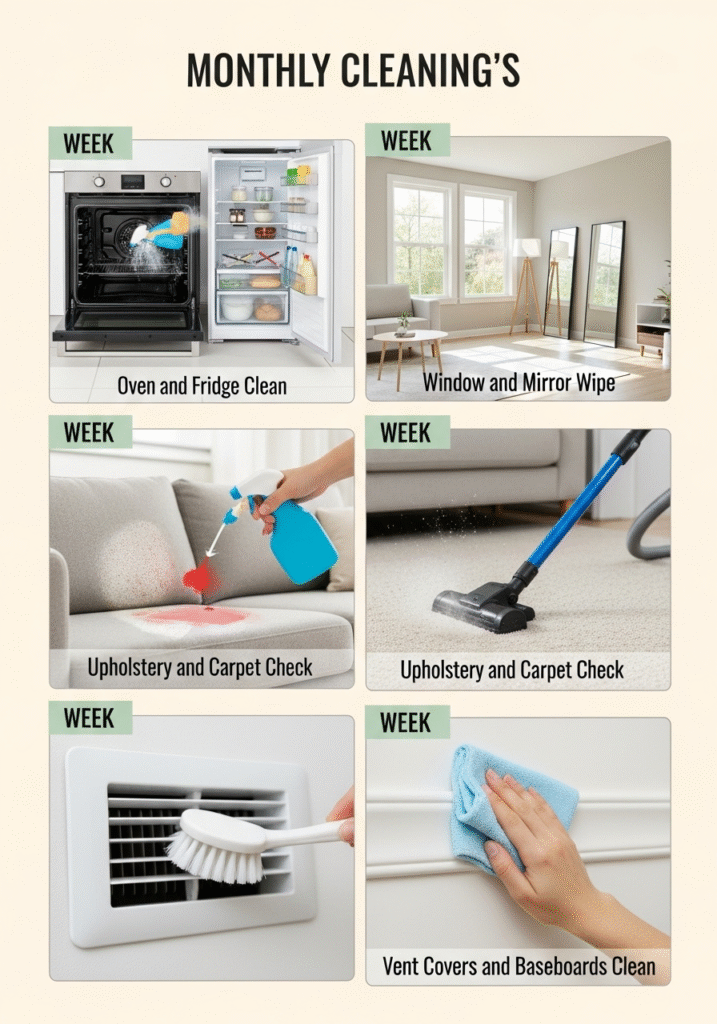
Seasonal (Every 3–4 Months)
Seasonal cleaning helps you stay ahead of the deep grime and clutter that can accumulate slowly over time. These tasks don’t need to be done every week or month, but doing them quarterly—aligned with the changing seasons—is just frequent enough to keep your home feeling fresh, healthy, and organized without creating extra stress. Consider tying these into a weekend project or spreading them out over a couple of days each season.
6.1 Declutter Closets
Our closets tend to fill up silently with items we no longer use. Tackling them seasonally helps keep your wardrobe and storage spaces functional and clutter-free.
- Purge Unused Clothing and Shoes: Go through each closet in your home, especially your bedroom and hallway closets. Pull out items that haven’t been worn or used in the past 6–12 months. If they no longer fit, are out of style, or don’t serve a purpose, consider donating them to a local shelter or thrift store.
- Reorganize by Season: Rotate seasonal clothing to the front or top of your closet, and store off-season items in bins or vacuum-sealed bags. This keeps your daily wardrobe easy to access and visually cleaner.
- Check for Damaged Items: While sorting, take a moment to inspect shoes and clothing for damage. Mend, clean, or toss items that are beyond repair.
6.2 Wash Bedding & Curtains
Bedding and curtains collect dust, skin cells, and allergens over time, even if they look clean. Washing them seasonally helps freshen the entire room and promotes better air quality and sleep hygiene.
- Deep-Wash Bedding: Strip beds completely and launder all bedding items, including duvet covers, pillow shams, mattress protectors, and even throw blankets. Follow care labels and use hot water when possible to kill dust mites and bacteria.
- Curtain Care: If your curtains are machine washable, remove and launder them using a gentle cycle. For delicate or dry-clean-only curtains, consider vacuuming with a brush attachment to remove dust. Don’t forget window valances or tie-backs, which often get overlooked.
- Bonus Tip: Flip or rotate your mattress while the bed is stripped to help it wear evenly over time.
6.3 Light Fixtures, Ceiling Fans & High Surfaces
High and hard-to-reach areas are magnets for dust and cobwebs—but often get skipped in regular cleanings. Addressing them every 3–4 months helps maintain air quality and visual cleanliness.
- Dust and Wipe Fixtures: Remove light shades or covers from chandeliers, pendant lights, and flush mounts. Wipe them down with a damp microfiber cloth. For extra grimy ones, soak in warm soapy water.
- Clean Ceiling Fans: Dust blades using a pillowcase (to trap dust without spreading it). Follow up with a damp cloth and cleaner to remove built-up grime. This is especially important before using fans more frequently in warmer months.
- Wipe Tall Surfaces: Clean the tops of cabinets, shelves, bookcases, refrigerator tops, and any rarely touched ledges where dust accumulates. Use a step stool for safe access and work from top to bottom.
6.4 HVAC & Filters
Clean, efficient air systems are essential for comfort, especially during seasonal transitions when heating or cooling use increases. Regular filter maintenance can also improve air quality and reduce energy costs.
- Replace or Clean HVAC Filters: If your system uses disposable filters, replace them quarterly (or more often if you have pets or allergies). If you have reusable filters, rinse and let them dry completely before reinserting.
- Kitchen Range Hood Filters: Grease and smoke build up quickly in range hood filters. Remove and soak in hot, soapy water (or degreaser) for 15–20 minutes. Scrub if necessary and let them dry before replacing.
- Vacuum and Clean Small Appliance Filters: Don’t forget about filters in vacuums, air purifiers, and dehumidifiers. Vacuum or rinse according to the manufacturer’s instructions to keep them running efficiently.
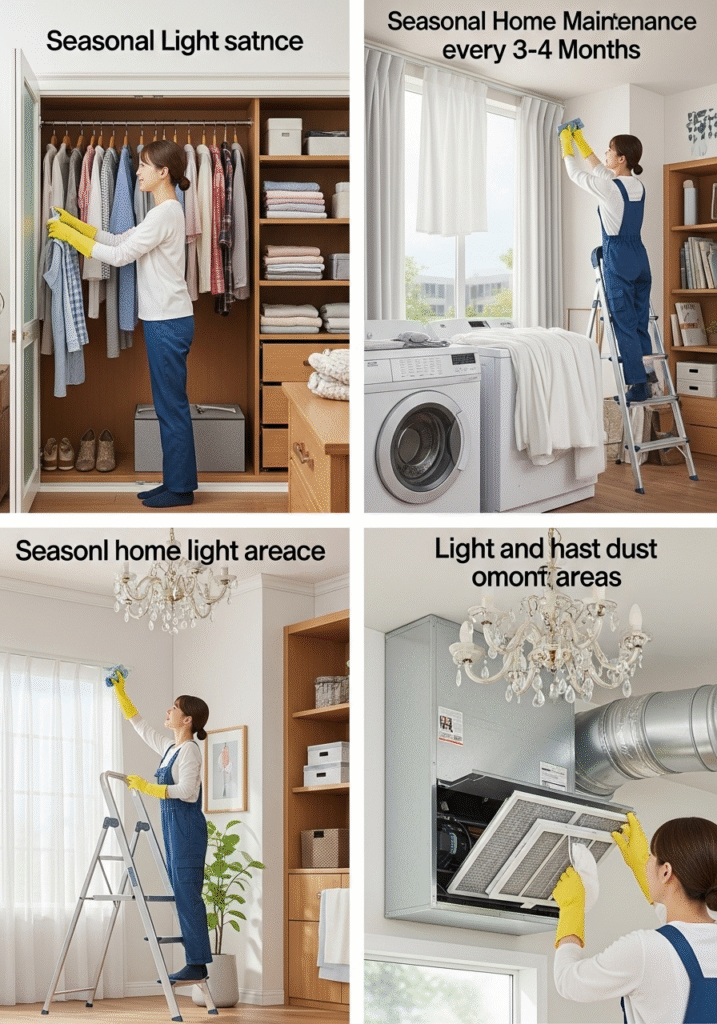
Smart Tools & Products for Efficiency
Your Attractive Heading
Keeping your home clean doesn’t have to be a hassle—especially if you’re equipped with the right tools. Having a thoughtfully chosen selection of smart, versatile cleaning products can dramatically cut down on the time and effort required for daily or weekly chores. These tools aren’t about owning more—they’re about owning better, and making your cleaning routine faster, easier, and more sustainable.
Here’s a breakdown of must-have cleaning tools that can streamline your routine and enhance your results.
All‑Purpose Sprays & Microfiber Cloths
At the heart of every efficient cleaning routine is a solid all-purpose cleaner paired with the right cloth.
- All-Purpose Sprays: These versatile cleaners are safe for a wide range of surfaces including countertops, tables, doorknobs, and more. Opt for non-toxic, biodegradable options for everyday use—especially in homes with children or pets.
- Microfiber Cloths: Unlike paper towels or cotton rags, microfiber cloths trap dust, dirt, and bacteria effectively with little to no need for chemical cleaners. They’re reusable, lint-free, and incredibly absorbent. Keep a few designated cloths in rotation for different zones—kitchen, bathroom, glass surfaces—to avoid cross-contamination.
Cordless Stick Vacuum
Gone are the days of lugging around a bulky upright vacuum for every minor mess.
- Lightweight and Convenient: A cordless stick vacuum makes quick work of daily debris like crumbs, pet hair, or dust bunnies. Its lightweight design and portability make it ideal for high-traffic areas, small spills, or daily touch-ups between deep cleans.
- Time-Saver: Most models come with attachments for tight corners, upholstery, or even cars. Wall-mounted chargers also keep them easily accessible and always ready to use.
- Bonus Tip: Use it as part of a nightly 5-minute reset—vacuum under the dining table or by entryways to instantly boost the cleanliness of your space.
Squeegee
An often-overlooked but powerful tool in maintaining a clean and mildew-free bathroom.
- Shower Wall Maintenance: Use a small squeegee to quickly wipe down shower walls and glass doors after each use. This prevents hard water stains, soap scum buildup, and mildew—dramatically reducing the frequency of deep cleaning.
- Other Uses: Great for windows, mirrors, and even tile floors in a pinch. Keep one hanging in the shower or stored with your bathroom cleaning supplies for easy access.
Toilet Bowl Station
Maintaining a clean toilet doesn’t have to be time-consuming when you have the right system in place.
- In-Bowl Tablets: These slow-release cleaning tablets help keep the toilet bowl fresher between manual scrubs. Look for bleach-free or septic-safe options depending on your system.
- Brush Holder Station: Pair the tablets with a dedicated toilet brush and a well-ventilated holder. Some modern designs include a drip tray or self-cleaning mechanism to reduce mess and odors.
- Why It Matters: When it’s easy to reach and ready to go, you’re more likely to do quick cleanups that prevent buildup.
Multi‑Purpose Cleaning Kit
Centralizing your supplies saves time and eliminates the excuse of “I don’t feel like grabbing everything.”
- What to Include: Fill a tote, caddy, or handled bucket with essential items like rubber gloves, microfiber cloths, scrub brushes, sponges, disinfectant spray, and all-purpose cleaner.
- Mobile & Modular: A portable kit allows you to move from room to room without making repeat trips to the cleaning closet. Whether you’re spot-cleaning spills, wiping surfaces, or tackling a weekend reset, you’ll have everything at hand.
- Label & Refill: Keep supplies organized and labeled if possible. Refill spray bottles, replace worn-out cloths, and restock gloves regularly to stay prepared.
Cleaning Caddy or Tote Bag
Efficiency is all about mobility—and a dedicated tote can transform your approach.
- Clean-On-the-Go: A sturdy, compartmentalized cleaning caddy helps you move efficiently through your home, completing tasks as you go. This is especially helpful during speed cleans or when doing your weekly quick-clean circuit.
- Encourages Consistency: Having your tools organized and ready reduces friction between intention and action. It also helps every household member contribute, since the supplies are easy to find and use.
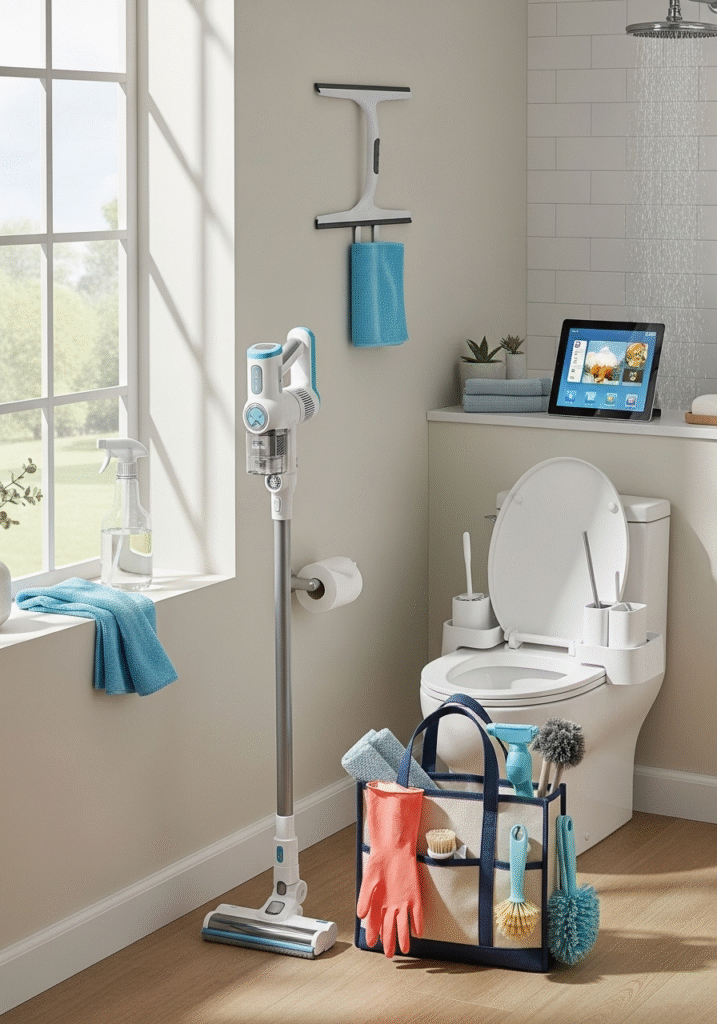
Maximize Productivity with a Cleaning Schedule
One of the most powerful ways to make cleaning less stressful and more sustainable is to treat it like any other important part of your life—by scheduling it. Whether you’re maintaining a household solo or managing chores with a partner or family, using a structured cleaning schedule turns a list of tasks into a manageable, time-saving routine. Better yet, when you harness the power of digital tools like calendars, alarms, or task management apps, your cleaning plan becomes automated, visual, and much easier to stick to.
When you schedule cleaning into your day intentionally, it shifts from being a nagging afterthought to a built-in part of your lifestyle.
Use Digital Tools to Stay on Track
Technology can make cleaning feel less overwhelming and more organized by giving you structure and gentle reminders that keep you consistent.
- Calendar Alerts: Use your digital calendar (Google Calendar, Apple Calendar, etc.) to create recurring tasks. Set small daily reminders like “Morning Kitchen Reset” or “Evening Living Room Tidy.” These short blocks help create habits and prevent buildup of mess.
- Reminder Apps: Apps like Todoist, Microsoft To Do, or built-in phone reminders allow you to set recurring checklists for daily, weekly, or monthly cleaning tasks. You can also group tasks by room or time of day.
- Smartphone Alarms or Timers: For micro-habits like wiping down the bathroom counter or putting away laundry, set an alarm that goes off the same time every day. It’s a small prompt that reinforces rhythm and consistency.
Set Daily Micro-Habit Reminders
Cleaning doesn’t have to be a time-consuming chore. The most efficient routines come from quick, daily actions that prevent messes from piling up. By setting specific times for small tasks, you build cleaning into your natural flow of the day.
- Examples of Micro-Habits to Schedule:
- “2-Minute Kitchen Tidy – 8:00 AM”: After breakfast, wipe counters, load any lingering dishes, and start fresh for the day.
- “Evening Reset – 8:30 PM”: Put away clutter, fluff cushions, fold blankets, and prep for tomorrow.
- “Bathroom Counter Wipe – 7:45 AM”: After brushing your teeth, do a 30-second wipe-down of the sink and faucet.
By making these actions automatic, your space stays neat with minimal effort—and you avoid time-consuming weekend cleanups.
Assign Weekly Tasks to Specific Days
Organizing your weekly tasks into themed cleaning days (as outlined in your Quick-Clean Routine) makes it easier to stay consistent and balanced.
- Example Weekly Cleaning Structure:
- Monday: Kitchen Deep Spot
- Tuesday: Bathroom Blitz
- Wednesday: Living Area Tidy-Up
- Thursday: Dusting & Surfaces
- Friday: Floors & Entry
- Weekend: Deep or monthly chore blocks
This approach ensures no area gets overlooked and avoids the burnout of trying to “do it all at once.” You only need 20–30 minutes a day to keep your home in great shape when tasks are broken down clearly.
Block Off 30-Minute Weekend Slots
Some tasks—like oven cleaning, washing curtains, or organizing closets—don’t fit into the daily schedule. Blocking time for them on the weekend helps you manage them intentionally without sacrificing your whole day.
- Tip: Add a recurring calendar event called “Weekend Cleaning Power Hour.” Split that hour into two 30-minute sessions (Saturday + Sunday), and assign one or two monthly/seasonal tasks to complete each time.
This time-boxed method helps you stay on top of deeper tasks while still enjoying your weekend.
Turn Cleaning into a Habit, Not a Burden
The biggest benefit of a scheduled cleaning routine is mental. When cleaning is built into your regular flow, it becomes part of your lifestyle—not an endless, guilt-driven to-do list.
- You spend less time thinking about when and how to clean.
- You avoid messes from becoming overwhelming.
- You train your brain to treat cleaning as a small, normal action—like brushing your teeth or making your bed.
It’s a productivity trick, a mental health boost, and a self-care practice all rolled into one.
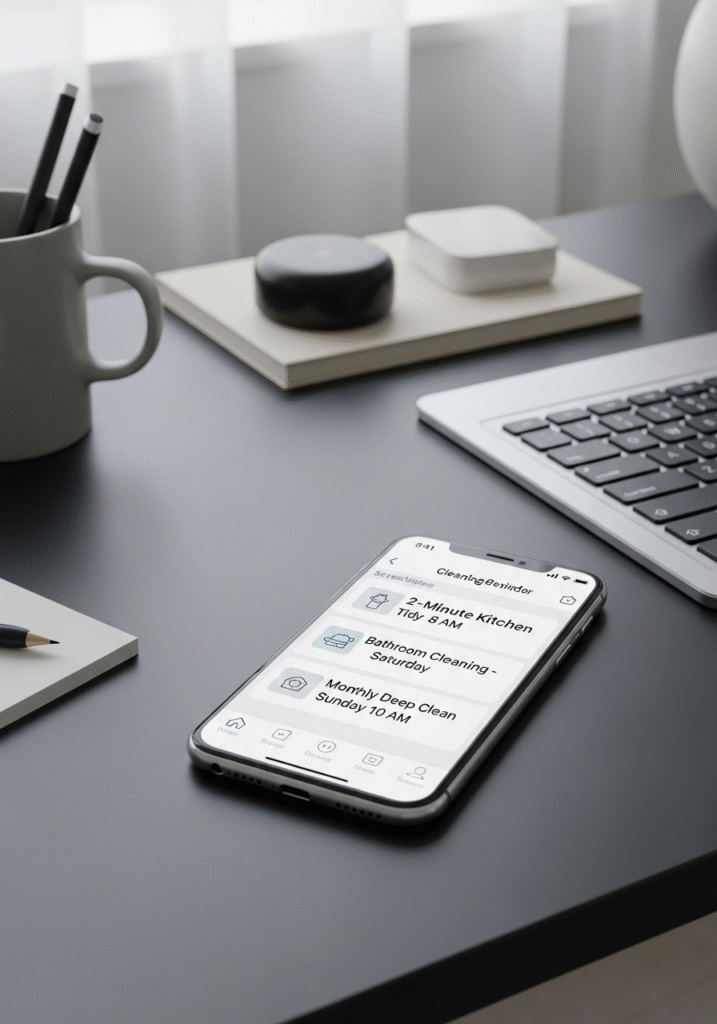
Tips for Delegating & Outsourcing
Even with the best systems in place, cleaning can still feel overwhelming—especially when you’re juggling work, parenting, errands, or caregiving. That’s where delegation and outsourcing come in. These aren’t signs of giving up control—they’re smart, sustainable strategies for managing your time, energy, and household effectively.
The ultimate goal of any home routine isn’t perfection—it’s peace of mind. By sharing the workload or investing in occasional help, you protect your time and prevent burnout, while still maintaining a clean and comfortable home.
Family Teamwork: Share the Load
Whether you live with a partner, kids, roommates, or extended family, everyone who shares the space can contribute to its upkeep. Delegating doesn’t have to be formal or complicated—but it should be intentional.
- Age-Appropriate Tasks: Even young children can learn responsibility through small chores like:
- Putting away toys
- Feeding pets
- Wiping down the table after meals
- Sorting laundry or matching socks
- Chore Charts or Task Rotations: A weekly chart or rotating responsibilities helps make cleaning expectations clear. This also helps avoid resentment or confusion over who’s responsible for what.
- Make It Routine, Not a “Favor”: Framing chores as shared responsibilities, not one-off asks, creates a stronger sense of ownership. Try setting a family “clean-up song” or post-dinner 10-minute tidy so it feels more like a habit than a punishment.
- Celebrate Contributions: Acknowledge and thank family members for doing their part. This builds cooperation and encourages consistency—especially with kids.
Hiring Help: Professional Cleaners Can Reinforce Your Efforts
You don’t have to do it all yourself. Bringing in a professional cleaner—whether once a season, once a month, or every other week—can be a huge mental and physical relief.
- Why It Helps: A pro can tackle deep-cleaning jobs (baseboards, grout, behind furniture) that you may not get to regularly. Their visit also creates a natural rhythm for keeping your space in order between appointments.
- How to Budget It: If weekly service feels too costly, try monthly visits to do the heavy lifting (bathrooms, kitchen scrubbing, floors) while you handle the light, daily upkeep. You can often customize services based on your needs and budget.
- Mindset Shift: Outsourcing cleaning doesn’t mean you’ve failed—it means you’re using your resources wisely to free up your time, energy, or attention for the things that matter most to you.
Trade Services with Friends or Neighbors
Not every household has the budget for professional help—but that doesn’t mean you’re out of options. Consider bartering services in your community or circle.
- Swap Skills: Offer something you’re good at—gardening, babysitting, meal prep, tutoring—in exchange for help with cleaning tasks. You might find a neighbor who enjoys organizing or someone looking to earn a bit of extra cash.
- Weekend Exchange Days: Set up a mini work-trade with a friend where you each take a couple of hours to help with the other’s home projects. Doing it together makes it feel more social and less overwhelming.
- Trust and Communication: Clear boundaries and agreements are key for these arrangements. Be specific about what you’ll each do, and always approach swaps with fairness and gratitude.
The Goal Is Sustainable Upkeep, Not Perfection
Remember: the purpose of delegating or outsourcing isn’t to create a magazine-perfect home. It’s to support your lifestyle and protect your well-being. A sustainable cleaning strategy adapts to your life—not the other way around.
- Let Go of the “Shoulds”: You don’t have to be the only one scrubbing floors or folding laundry to have a clean home. Sharing the work is smart, not lazy.
- Think in Seasons: During especially busy seasons (new job, new baby, illness, or travel), lean more heavily on others. When life slows down, you can take back more tasks if desired.
- Mental Clarity: A clean, functioning home can reduce stress, improve focus, and help you feel more in control. But that doesn’t mean you have to do it all. Delegating is an act of self-care.
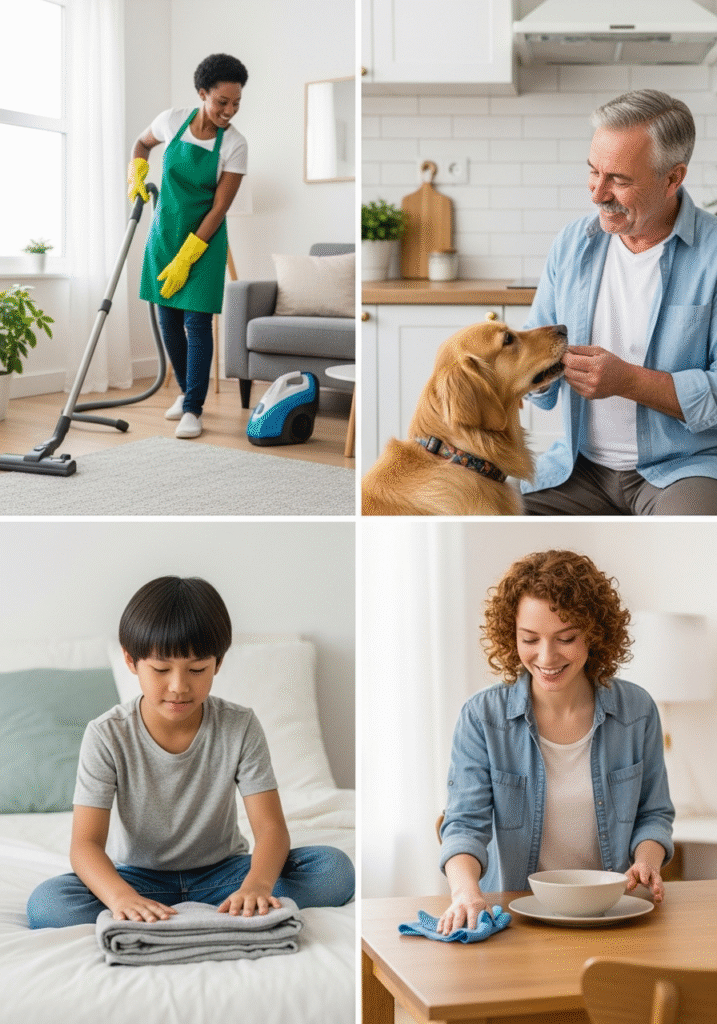
Your Conclusion & Final Encouragement
A clean, peaceful home doesn’t require perfection or endless hours of work—it requires consistency, smart planning, and a mindset shift. In a world where our to-do lists are already overflowing, it’s easy to let home care feel like just another burden. But with the right system in place, maintaining a comfortable and welcoming space becomes achievable, efficient, and even rewarding.
Throughout this guide, you’ve explored how to break down cleaning into bite-sized pieces—starting with small daily habits, assigning one focus per weekday, and layering in monthly and seasonal tasks for deeper upkeep. You’ve also seen how the right tools, teamwork, and scheduling strategies can transform cleaning from a chore into a sustainable part of your routine.
Here’s the core truth: you don’t have to do everything at once to have a consistently clean home. You just need to start with what feels manageable, and build from there.
Start Small—And Build With Confidence
The best way to begin is by taking action on just a few tasks—ones that give you a noticeable return on effort. This not only creates visible results, but boosts your motivation to keep going.
Try this as your Week One plan:
- Choose two micro-habits: For example, wipe the kitchen counters every morning and do a 5-minute clutter sweep each evening.
- Pick one weekly focus task: Maybe “Bathroom Blitz Tuesday” or “Dusting Thursday”—something simple and satisfying.
- Use a reminder app or calendar alert to build momentum with gentle nudges that fit your routine.
This small start will anchor your day and week with a few easy wins. You’ll start to notice how quickly these habits become second nature—and how much lighter home care can feel.
Consistency Beats Perfection
The power of this system lies not in doing everything perfectly, but in doing something regularly. A 10-minute tidy is better than no tidy. A quick sweep of the floor is better than waiting for the “perfect” time to deep-clean. Over time, these small wins add up to big results.
By sticking to this approach—even loosely—you’ll avoid the dreaded “all-at-once” cleaning weekends and instead maintain a level of order that makes your home feel calm and livable every day.
Celebrate the Wins—Big or Small
Give yourself credit for every bit of progress. Folding laundry before bed, doing dishes right after dinner, or remembering to clean the doormat—these are all victories. Celebrate them. Acknowledge that you’re not just cleaning—you’re creating space for rest, focus, connection, and clarity.
You’re not failing if some days slip by. You’re building a rhythm that respects your time and energy, while still prioritizing the comfort of your environment.
A Lifestyle, Not a List
Ultimately, this system isn’t about strict schedules or rigid rules. It’s a flexible framework designed to work with your life—not against it. Some weeks will feel chaotic; others will run smoothly. That’s okay. The system is designed to adapt, not overwhelm.
Whether you live in a studio apartment or a busy family home, you can weave cleaning into the fabric of your lifestyle in a way that feels empowering—not exhausting.
Final Encouragement
Remember: a consistently clean and inviting home is completely within reach—even with a full schedule and a busy mind. By using small daily actions, manageable weekly tasks, monthly refreshers, and seasonal resets, you’re investing in the long-term health of your home and your peace of mind.
Start simple. Stay consistent. Adjust as needed. And most of all—be proud of every step you take toward a home that supports you, not one that stres
